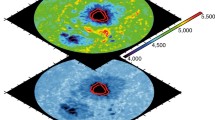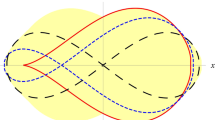Abstract
Bulk energization of electrons to 10 – 20 keV in solar flares is attributed to dissipation of Alfvén waves that transport energy and potential downward to an acceleration region near the chromosphere. The acceleration involves the parallel electric field that develops in the limit of inertial Alfvén waves (IAWs). A two-potential model for IAWs is used to relate the parallel potential to the cross-field potential transported by the waves. We identify a maximum parallel potential in terms of a maximum current density that corresponds to the threshold for the onset of anomalous resistivity. This maximum is of order 10 kV when the threshold is that for the Buneman instability. We argue that this restricts the cross-field potential in an Alfvén wave to about 10 kV. Effective dissipation requires a large number of up- and down-current paths associated with multiple Alfvén waves. The electron acceleration occurs in localized, transient, anomalously conducting regions (LTACRs) and is associated with the parallel electric field determined by Ohm’s law with an anomalous resistivity. We introduce an idealized model in which the LTACRs are (upward-)current sheets, a few skin depths in thickness, separated by much larger regions of weaker return current. We show that this model can account semi-quantitatively for bulk energization.

Similar content being viewed by others
References
Achterberg, A.: 1981, Astron. Astrophys. 97, 259.
Asamura, K., Chatson, C.C., Itoh, Y., Fujimoto, M., Sakanoi, T., Ebihara, Y., et al.: 2009, Geophys. Res. Lett. 36, L05105. doi: 10.1029/2008GL036803 .
Bian, N.H., Kontar, E.P., Brown, J.C.: 2010, Astron. Astrophys. 519, A114. doi: 10.1051/0004-6361/201014048 .
Borovsky, J.E.: 1993, J. Geophys. Res. 98, 6101. doi: 10.1029/92JA02242 .
Brown, J.C., Bingham, R.: 1984, Astron. Astrophys. 508, 993.
Büchner, J., Elkina, N.: 2005, Space Sci. Rev. 121, 237. doi: 10.1007/s11214-006-6542-6 .
Buneman, O.: 1958, Phys. Rev. Lett. 1, 8. doi: 10.1103/PhysRevLett.1.8 .
Buneman, O.: 1959, Phys. Rev. 115, 503. doi: 10.1103/PhysRev.115.503 .
Chaston, C.C., Peticolas, L.M., Bonnell, J.W., Carlson, C.W., Ergun, R.E., McFadden, J.P., Strangeway, R.J.: 2003, J. Geophys. Res. 108, 1091. doi: 10.1029/2001JA007537 .
Chaston, C.C., Hull, A.J., Bonnell, J.W., Carlson, C.W., Ergun, R.E., Strangeway, R.J., McFadden, J.P.: 2007, J. Geophys. Res. 112, A05215. doi: 10.1029/2006JA012007 .
Colgate, S.A.: 1978, Astrophys. J. 221, 1068. doi: 10.1086/156111 .
Copil, P., Voitenko, Y., Goossens, M.: 2010, Astron. Astrophys. 510, A17. doi: 10.1051/0004-6361/200912784 .
Cramer, N.F.: 2005, The Physics of Alfvén Waves, Wiley-VCH, Berlin, 52. doi: 10.1002/3527603123 .
Damiano, P.A., Wright, A.N., McKenzie, J.F.: 2009, Phys. Plasmas 16, 062901. doi: 10.1063/1.3142479 .
Emslie, A.G., Hénoux, J.C.: 1995, Astrophys. J. 446, 371. doi: 10.1086/175796 .
Fletcher, L., Hudson, H.S.: 2008, Astrophys. J. 675, 1645. doi: 10.1086/527044 .
Goertz, G.K.: 1984, Planet. Space Sci. 32, 1387. doi: 10.1016/0032-0633(84)90081-3 .
Haerendel, G.: 2012, Astrophys. J. 749, 166. doi: 10.1088/0004-637X/749/2/166 .
Hasegawa, A.: 1976, Solar Phys. 47, 325. doi: 10.1007/BF00152271 .
Holman, G.D.: 1985, Astrophys. J. 293, 584. doi: 10.1086/163263 .
Hoyng, P., Brown, J.C., Van Beek, H.F.: 1976, Solar Phys. 48, 197. doi: 10.1007/BF00151992 .
Kletzing, C.A.: 1994, J. Geophys. Res. 99, 11905. doi: 10.1029/94JA00345 .
LaRosa, T.N., Moore, R.L.: 1993, Astrophys. J. 418, 912. doi: 10.1086/173448 .
LaRosa, T.N., Moore, R.L., Shore, S.N.: 1994, Astrophys. J. 415, 856. doi: 10.1086/174031 .
Litvinenko, Yu.E., Somov, B.V.: 1991, Solar Phys. 131, 319. doi: 10.1007/BF00151641 .
Luo, Q., Melrose, D.: 2006, Mon. Not. Roy. Astron. Soc. 368, 115. doi: 10.1111/j.1365-2966.2006.10191.x .
Lysak, R.L., Lotko, W.: 1996, J. Geophys. Res. 101, 5085. doi: 10.1029/95JA03712 .
Lysak, R.L., Song, Y.: 2003, J. Geophys. Res. 108, 8005. doi: 10.1029/2002JA009406 .
MacKinnon, A.L., Brown, J.C.: 1989, Solar Phys. 122, 303. doi: 10.1007/BF00912997 .
McClements, K.G., Fletcher, L.: 2009, Astrophys. J. 693, 1494. doi: 10.1088/0004-637X/693/2/1494 .
Melrose, D.B.: 1986, Instabilities in Space and Laboratory Plasmas, Cambridge University Press, Cambridge, 38.
Melrose, D.B.: 2012a, Astrophys. J. 749, 58M. doi: 10.1088/0004-637X/749/1/58 .
Melrose, D.B.: 2012b, Astrophys. J. 749, 59M. doi: 10.1088/0004-637X/749/1/59 .
Melrose, D.B., Wheatland, M.S.: 2013, Solar Phys. doi: 10.1007/s11207-013-0305-9 .
Seyler, C.E., Liu, K.: 2007, J. Geophys. Res. 112, A09302. doi: 10.1029/2007JA012412 .
Simon, A.: 1955, Phys. Rev. 98, 317. doi: 10.1103/PhysRev.98.317 .
Spicer, D.S.: 1982, Space Sci. Rev. 31, 351. doi: 10.1007/BF00171370 .
Spicer, D.S., Sudan, R.N.: 1984, Astrophys. J. 280, 448. doi: 10.1086/162011 .
Stasiewicz, K., Bellan, P., Chaston, C., Kletzing, C., Lysak, R., Maggs, J., et al.: 2000, Space Sci. Rev. 92, 423.
van den Oord, G.H.J.: 1990, Astron. Astrophys. 243, 496.
Wild, J.P., Smerd, S.F., Weiss, A.A.: 1963, Annu. Rev. Astron. Astrophys. 1, 291. doi: 10.1146/annurev.aa.01.090163.001451 .
Acknowledgements
We thank Neil Cramer for helpful advice on dispersive Alfvén waves.
Author information
Authors and Affiliations
Corresponding author
Appendices
Appendix A: Wave Equation for KAWs
In kinetic theory, the response of the electrons is described in terms of the plasma dispersion function with an argument \(y=(\omega ^{2}/2k_{z}^{2}V_{\rm e}^{2})^{1/2}\). The cold electron limit corresponds to y≫1. The parallel component of the dielectric tensor then reduces to the cold plasma form \(K_{zz}=1-\omega_{\rm p}^{2}/\omega^{2}\), and this cold plasma response leads to Equation (12). In the opposite limit (y≪1) one has
where the ions are assumed cold, \(\omega_{\rm pi}\) is the ion plasma frequency, and \(\lambda_{\rm De}=V_{\rm e}/\omega_{\rm p}\) is the electron Debye length. The final term in Equation (31) corresponds to a quasi-static, one-dimensional screening, satisfying \((\partial^{2}/\partial z^{2}+1/\lambda_{\rm De}^{2})\Psi=-\rho_{\rm ext}/\varepsilon_{0}\) for any extraneous charge density \(\rho_{\rm ext}\). Making the replacements ω 2→−∂ 2/∂t 2 and \(k_{z}^{2}\to-\partial^{2}/\partial z^{2}\), in place of Equation (11) one finds
Neglecting the first term in Equation (32) gives
Combining Equations (7) and (33), one obtains the wave equation for KAWs in a form analogous to Equation (13):
After Fourier transforming, Equations (4), (33), and (34) imply the wave properties in Equation (2). The requirement \(v_{\rm A}^{2}\ll V_{\rm e}^{2}\) renders KAWs of little interest in the present context.
More detailed treatments of KAWs are available (Hasegawa 1976; Lysak and Lotko 1996; Lysak and Song 2003; Damiano, Wright, and McKenzie 2009). In particular, the value of the parameter \(R_{\rm g}\) in Equation (2) derived by Hasegawa (1976) is (Lysak and Lotko 1996)
where \(V_{\rm i}^{2}=T_{\rm i}/m_{\rm i}\) and \(\Omega_{\rm i}=q_{\rm i}B/m_{\rm i}\) are the thermal speed and gyrofrequency, respectively, of ions of mass \(m_{\rm i}\) and charge \(q_{\rm i}\).
Appendix B: Scalar and Vector Potentials
Stasiewicz et al. (2000) derived the properties of IAWs using the conventional description of the electromagnetic field in terms of the scalar potential, ϕ, and the vector potential, \({\bf A}\):
where \(\delta{\bf B}\) is the magnetic field in the wave. These authors gave an argument for assuming \({\bf A}_{\perp}=0\). (We interpret \({\bf A}_{\perp}=0\) as the gauge condition in the case where \({\bf\nabla }\times {\bf E}_{\perp}\) is set to zero, because it describes magnetoacoustic rather than Alfvén waves.) With \({\bf A}=A_{z}{\hat{\bf z}}\), Equation (36) becomes
An arbitrary gauge transformation involves an arbitrary function, ψ say, with the new potentials given by
The two-potential model follows by assuming \(A'_{z}=0\), implying that ψ is determined by ∂ψ/∂z=A z . One then finds
We conclude that the two descriptions are equivalent.
Rights and permissions
About this article
Cite this article
Melrose, D.B., Wheatland, M.S. Bulk Energization of Electrons in Solar Flares by Alfvén Waves. Sol Phys 289, 881–897 (2014). https://doi.org/10.1007/s11207-013-0376-7
Received:
Accepted:
Published:
Issue Date:
DOI: https://doi.org/10.1007/s11207-013-0376-7




